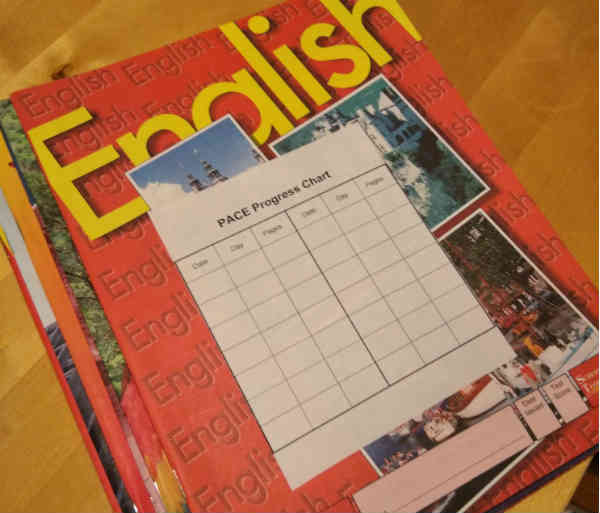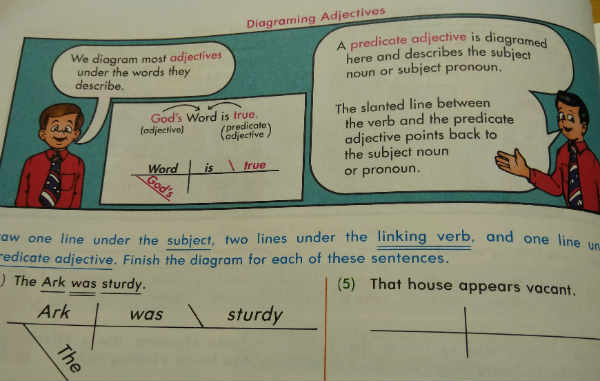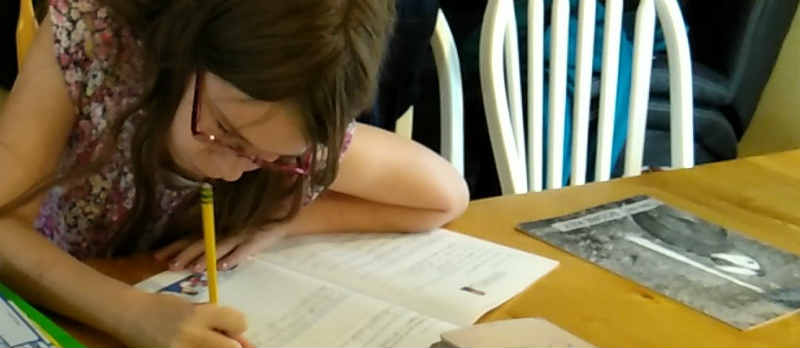Do you ever wonder how a mom with a houseful of kids can homeschool them all? How can any one person be able to teach every subject to each student at a level the child can understand? My primary strategy is to provide self-paced curriculum which my children can complete independently, especially for subjects like English.

Strengths of ACE English
Even elementary kids can enjoy completing these short, colorful, mastery-based workbooks on their own. The grammar is very thorough, and good cursive handwriting is emphasized.
When switching from another English program to ACE, we always make use of the free online placement tests. These assessments identify gaps in a student’s understanding and provide a prescription of “gap PACEs” the child may need to complete before starting at her actual grade level. Because ACE English covers grammar so thoroughly, students from other programs often score lower than expected. No grade levels are printed on the actual PACEs, so even if my child needs to complete PACEs from a previous grade, it is not obvious from the cover.
Little teacher preparation is needed to administrate this curriculum. When my daughter is ready to begin a PACE, I remove the test from the center, store it in my test binder, write her name and the date on the PACE and hand it to her. ACE recommends having your child set daily goals, and I tape a progress chart to the front of each PACE for this purpose. My daughter works through the PACE independently, scoring her own work as she goes.
The PACEs themselves feature comic-style drawings of kids my daughter’s age who introduce each concept. The instruction is concise, so there is not a tremendous amount of reading that kids may be tempted to skip. After reading the material, my daughter completes a page or two of exercises to practice the new skill. Because this is a worktext, she can write directly in the PACE. Every few pages, there is a score strip (checkpoint) which directs her to check her own work with the answer key, make corrections if necessary, then rescore the page.

While using the PACEs, my children master English skills I never learned. For example, ACE’s English PACEs teach students step by step how to diagram sentences. Even though I never really studied diagramming, it really is not that difficult, and I know it is helping my kids truly understand grammar. I also never heard of sentence patterns, but my middle school girls are becoming experts at identifying them.
The high school English PACEs continue to be strong on grammar, providing plenty of review and practice. High school students also study works of literature like The Hiding Place and write various compositions, including a research paper.
All of ACE’s PACEs have a strong emphasis on Bible and Christian character. Each one includes a Bible verse to memorize. Every few pages, my daughter writes down part or all of the verse to help her learn it. In addition, each PACE focuses on an associated character quality. Short comic strips and stories throughout the PACE give examples of that character trait in action.
Weaknesses of ACE English
Grammar too strong?
One consequence of a strong grammar curriculum is the possibility that a child simply may not be ready to learn the level of grammar included for her grade. One of my daughters hit a wall while working through the fifth grade PACEs at age 10. She simply could not understand the material no matter how hard she tried. When she failed the test, I sat down with her while she worked through the PACE a second time. Even after we worked through it together, she barely passed the test, and I could see that she needed to try something different. We spent a year using a different grammar program and then another year with a separate writing program before returning to PACEs this fall. Now that she is older, her brain is ready for the more advanced material, and she has breezed most of through the fifth and sixth grade gap PACEs. After she completes a handful of seventh and eighth grade PACEs, she will be ready to tackle high school English.
The high school PACEs may have too much emphasis on grammar. ACE’s elementary and middle school curriculum helps students develop a complete understanding of grammar before attempting high school work. Any student who has finished the 8th grade English PACEs understands grammar better than most adults and does not need the amount of review provided in the high school PACEs.
Gaps in Writing
While being strong on grammar, the PACEs provide insufficient support and instruction in writing. I want my children to enjoy writing and become great writers. Writing assignments in PACEs are few and far between, and my children are often uncertain how to approach them. Most levels of ACE English through middle school contain just one PACE that is very heavy on writing. Inevitably, students become overwhelmed at the amount of writing required all at once. They would be much better served if the writing assignments were distributed throughout each level.
My 13-year-old is stuck in the middle of a writing-intensive PACE right now. She had anticipated completing the last of her 6th grade gap PACEs before leaving for Thanksgiving but was unable to find the creative inspiration necessary for the assignments. She also succumbed to the temptation to skip pages. At the rate she is progressing, it will take her three times longer to complete this PACE than any of the others she has encountered, and she has fallen behind the schedule she wanted to keep.
Not only do the PACEs give insufficient writing practice and instruction for the students, but there are also no resources for grading upper-level writing assignments. I am often uncertain of the most effective way to score my child’s writing. Because of the shortcomings of ACE’s writing instruction, I am using additional resources to teach writing to my students.
ACE Kids & Scoring
Younger kids appreciate the comic-style characters included in the PACE. As my children have moved into the upper grades, however, they have complained about how the ACE kids depicted in each PACE seem too stereotyped and unrealistic. My daughter relates, “They are like robots who always do what’s right, and if they happen to mess up, they respond perfectly to authority.” My oldest daughter compared the perfect ACE kids to the more realistic kids depicted in books like The Chronicles of Narnia. Lewis’ true-to-life characters are good kids who make mistakes and truly learn from them.

While the design of PACEs is great for fostering independence and alleviating my burden as a mom, self-scoring can be a source of temptation for the student. My daughter may simply skip the important step of scoring her work and miss the opportunity to learn from her mistakes. Or she may be tempted to copy the answers from the score key rather than reading and doing the work herself. In order to avoid these temptations, I attempted to score all of my children’s work the first year we used PACEs. With five students at the time, this was overwhelming and led to one burned out Mama! I would not recommend it.
Now that my children are again using PACEs for most of their subjects, I keep the score keys on the kitchen table during our school day and require my children to go to the table to score their work. The score key must be closed unless they are actively scoring a page. In addition, I periodically inspect my children’s work to be sure it has been completed and accurately scored. If it has not, I sit down together with that child while she scores and corrects her work. I keep all the score keys for tests in my own private binder and personally grade every test.
High School English with PACEs
If you find the perfect English curriculum that will work for everyone, please let me know! ACE provides the most thorough grammar instruction I have found, and its coverage of high school literature is sufficient. My oldest daughter used English PACEs for most of high school, supplementing with a creative writing course her senior year. My son (now a senior) used PACEs for ninth and tenth grade English, then used a separate writing curriculum for the majority of eleventh and twelfth grade. Because he did not study the PACEs that covered American Lit, I also had him take a semester-long American Literature course this year.
My 13-year-old daughter is completing gap PACEs for middle school before beginning the ninth grade PACEs. My twins have another year and a half of middle school English PACEs. I will probably use a combination of PACEs and a separate writing program for their high school English, but I plan to approach it differently than with my oldest two. Instead of skipping whole grade levels of English PACEs, I may eliminate the PACEs that cover specific writing skills since they will be covering that material much more thoroughly in their writing program. Since it is best to tailor the curriculum to each child’s needs, I will remain flexible and open to utilizing other resources if they provide a better fit for a particular child.